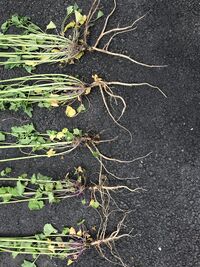Garlic Mustard
Alliaria petiolata ( USDA, Wikipedia, GoBotany, CISMA )

Garlic Mustard shoots up in thickets up to 3ft. in height from basal rosettes in both grasslands and woods. The leaves on the rosettes and the lower parts of mature plants are kidney shaped, while the stem leaves are alternate and deltoid, decreasing in size as they go up the stem. The leaves give off the odor of garlic when crushed, and have wide tooths on their edges. It has white flowers, appearing in April/May, with seeds produced by May.
Due to its ability to thrive in low-light, it crowds out the native spring ephemerals that are otherwise a lovely and diverse part of the wild understory. It even damages the fungal communities that trees depend on; and it threatens some butterfly populations that are looking to lay eggs on native mustard plants and find the non-sustaining garlic mustard plants instead. We humans introduced it to this area as a salad plant late in the 19th century, but it has escaped our gardens since then, and is growing wild and thick.
The good news is that it is easy to identify, and it can be hand-picked to extirpation in five years of Spring (and sometimes Fall/Winter) picking sessions.
Garlic Mustard, like many invasive plants, takes two years to mature before generating seed. The first year plants, or basal rosettes, are limited to kidney shaped leaves. The second (and later) year plants additionally sprout stems with the distinctive Garlic Mustard deltoid shape, and go on to flower and generate seeds. Many references erroneously call Garlic Mustard a biennial, when it is really a herbacious perennial: the plant does not die after the second year. The root cluster will continue to grow additional roots and it will have additional stems in later years.

Garlic Mustard is found on all Acton conservation lands. Together, we can get it out of there. Volunteer!
Removal
Removal requires repeated picking of the second (and later) year plants before they make seed. Their tall shoots and white flowers make them easy to identify. Grasp the plant around the base or the lower stem and gently start pulling --- you want to get all of the main root. If it breaks off, the plant will regrow.

Place the picked plants in opaque/dark trash bags and do not allow them to be composted. After picking a plant may still release seed.
Revisit the infestation every year in late April/early May and pick any newly matured second year plants. After six or seven years, this should no longer be necessary!
Common Mis-identifications
Around Acton, the plant most likely to be mis-identified as Garlic Mustard is one of the Crane's-bill, such as the Small-Flowered Crane's-bill (Geranium Pusillum) or Dove's-foot Crane's-bill (Geranium Molle). They have lobes in the leaf edges, unlike the relative minor jagged edges of Garlic Mustard Rosettes. Crane's-bills are also non-native to North America, but are not currently considered invasive in Acton.
CISMA suggest that the following native plants may be mis-identified as Garlic Mustard:
- Cut-leaved toothwort (Cardamine concatenata) resembles garlic mustard but is smaller and has narrow, finger-like leaves
- Wooly sweet-cicely (Osmorhiza claytonii) and Long-styled sweet-cicely (Osmorhiza longistylis), which have fern-like leaves and five petals
- Early small-flowered saxifrage (Micranthes virginiensis)